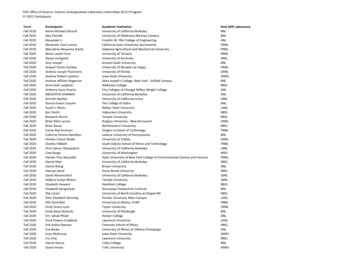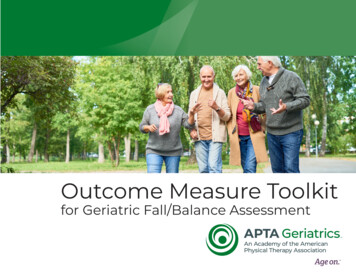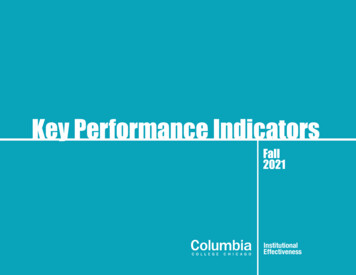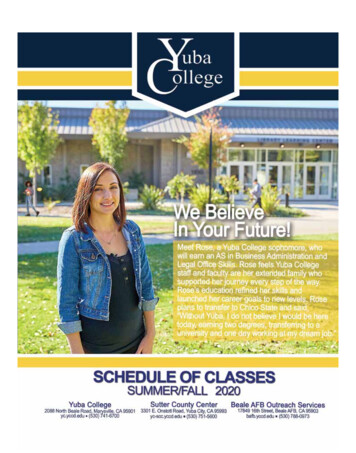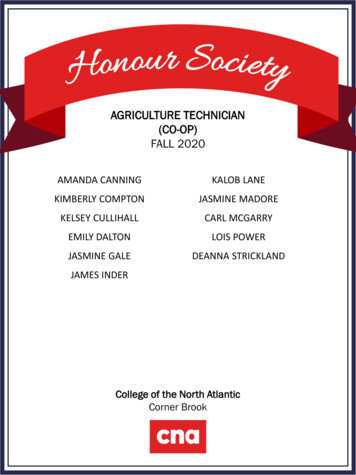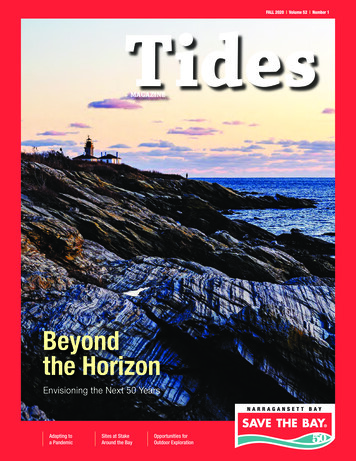
Transcription
FALL 2020 Volume 52 Number 1TidesMAGAZINEBeyondthe HorizonEnvisioning the Next 50 YearsAdapting toa PandemicSites at StakeAround the BayOpportunities forOutdoor Exploration
Narragan sett Baywasn’tthis.ekilsalwayPHOTO BY ONNE VAN DER WALREMEMBER THE PAST. PROTECT THE FUTURE.Save The Bay You Love.Join today to support our ongoing efforts at www.savebay.org/joinCELEBRATE SAVE THE BAY’S 50TH ANNIVERSARY WITH.SAVING NARRAGANSETT BAYHow People, Passion, and Perseverance Made All The DifferenceThe environmentalcleanup of Rhode Island’sNarragansett Bay isa story about community.53000 SAVING NARRAGANSETT BAYHow People, Passion, and PerseveranceMade All the DifferenceTODD MCLEISH 30.00ISBN 978-0-578-65569-7A 10-chapter history book, authored by Todd McLeish, and featuring the stunningphotography of Onne van der Wal, Salvatore Mancini, Carmel Vitullo, and more!ETT BAYIt is a story about citizens coming together,decade, to protect anatural resource that time and time again, decade aftershapes and definesthe region’s identity.Save The Bay is honored and proud to preseHow People, Passiont this story in Savinn, and PerseveranceMade All The Differenceg Narragansett Bay:.Discover the stories,organizations and indivcleanup of the Bayiduals that have contrin thisfeaturing stunning histor book written by local author, Todd McLeibuted to theic and present-day photoish, andSalvatore Mancini,graphy by Onne vanCarmel Vitullo, andder Wal,others.SAVING NARRAGANSDiscover the never-before-told personal stories,critical victories, and powerful voices thathave contributed to the remarkable cleanup ofNarragansett Bay.9 780578 655697By Todd McLeish On Sale Now!WWW.SAVEBAY.ORG/SAVINGNB2020This project was funded in part bythe Heritage Harbor Foundation
SAVEBAY.ORG3FROM THE DIRECTORA Commitmentfor the FutureOver the past three issues of Tides,we have taken a look back in time, takingstock of major milestones in the cleanup ofthe Bay since 1970. We have also exploredour evolution as an organization since ourfounding 50 years ago.In this issue, we turn our sights to thefuture. We live in a constantly changingworld, a world in which the cumulativeimpact of human behavior and land usechanges are threatening the progressmade in cleaning up Narragansett Bay.Compounding this challenge is the subtle,but profound, influence of rapid climatechange on the Narragansett Bay ecosystem.Against this backdrop is the reality ofstrained government resources.Protecting what we love, this livingresource we call Narragansett Bay, requiresa sober commitment to three imperatives:respect the science, conserve natural places,and reduce pollution.Our work, whether advocating at theState House or inspiring the next generation of Bay stewards, is guided by the bestavailable science. We are committed to protecting the health of the Bay watershed andpreserving open space and natural systemsin coastal areas and uplands. And we aredetermined to reduce all forms of pollutionthat foul the Bay and threaten animal andmarine life. This, it turns out, is a movingWhat’s Inside.target as warming temperatures exacerbatethe harm caused by nitrogen loads and relatively new forms of pollution, such as plasticsand household chemicals.Our ability to affect positive changedepends on you. The example you set in thechoices you make in your daily lives matters.Your willingness to engage in environmentalissues in the political process at the local,state, and federal level matters. And yoursupport of our efforts, whether it be as avolunteer, an advocate, or a member anddonor matters.If the past is any guide, together we canmake a real difference. Not just in protectinggains achieved, but in improving the healthof the Bay for our kids and grandkids. Everypositive step we take now will enhance theresilience of the Bay for years to come.Thank you for your passion and commitmentto this cause.With appreciation,Jonathan StoneExecutive Director4Adapting to a PandemicHow Save The Bay’s events andprograms went virtual.8EducationOpportunities for outdoorexploration during COVID-19.10Who Saves the Bay?Staff Profile:Maureen Fogarty12RestorationTaking inventory of a retiredcranberry bog.14Cover StoryBeyond the Horizon: Envisioningthe Bay’s next 50 years.17AdvocacyFamiliar sites around the watershedface challenges.21Who Saves the Bay?Volunteer Spotlight:David Murray22Who Saves the Bay?Donor Spotlight:Jane Garnett and David Booth24ArchivesRevisiting our first salt marshrestoration project.ON THE COVER:Beavertail Lighthouse, Jamestown.Photo by Aaron Field Simmons.TIDES MAGAZINE Save The Bay 100 Save The Bay Drive, Providence, RI 02905401-272-3540 savebay.org tides@savebay.orgMission and Vision: Save The Bay works to protect and improve Narragansett Bay and its watershed throughadvocacy, education and restoration efforts. We envision a fully swimmable, fishable, healthy NarragansettBay, accessible to everyone and globally recognized as an environmental treasure.
Tides Magazine Fall 20204Adapting toa PandemicMarch 16, 2020 marked Save The Bay’s first day of working from home.As COVID-19 prompted stay-at-home orders across the region, staff begannavigating the unfamiliar challenges of protecting and improving NarragansettBay while distanced from our facilities, one another, and our community.Already equipped with the digital tools needed to work remotely, we leaptinto action with creative problem-solving, unbridled teamwork and communitymindedness. Below are the highlights from what may be Save The Bay’s mostinventive summer to date.Giving BackB Y K AT Y D O R C H I E S , D I R E C T O R O FC O M M U N I C AT I O N S A N D M A R K E T I N G ,A N D M A C K E N S I E D U P O N T C R O W L E Y,C O M M U N I C AT I O N S S P E C I A L I S TSave The Bay’s Taste of The Bay fundraiser has always been a celebration of the flavors,sights and sounds of Narragansett Bay. Guests annually convene at our Providence Bay Center to enjoy samplings of local food and drink—all of which is donated by local restaurants,shellfishermen, bakeries, breweries and wineries. When the 2020 event could not continue asscheduled, we transformed it into a fundraiser to support our loyal partners in the strugglinglocal food and beverage industries. In under three weeks, we sold enough tickets to raise 4,200 for our partners!Above: A traditional Taste of The Bay event usually takes place in-person at our Bay Center. Thisyear, we flipped the script and supported the food and drink industry whose goods we’ve enjoyed overthe years. Left: This summer’s Virtual Swim and Open invited swimmers like John Miniati, shownhere, to complete a half-mile or two-mile swim remotely, at local beaches, ponds or pools.The Swim Goes VirtualFor 43 years, Save The Bay’s iconic Swim fundraiser has raised funds and awareness for ourmission to protect and improve Narragansett Bay. Athletes and advocates alike acceptedthe challenge of a two-mile, cross-Bay swim from Newport to Jamestown. When it becameFIVE DECADESOF PROGRESS:1970-TODAY19821970Save The Bay is founded after Save OurCommunity defeatsa proposal for an oilrefinery on the shoresof Tiverton.1972We champion andparticipate in theformation of theCoastal ResourcesManagementCouncil.1977One hundred people takepart in a cross-Bay swimfrom Jamestown to Newport to raise awarenessof water quality issues inNarragansett Bay. The SaveThe Bay Swim is born.We win passage ofan 87 million Baybond to fund theupgrade and repairof the Providencetreatment facility.
SAVEBAY.ORG5 120,000RAISEDTeams of close friends (above and right) gathered insmall groups along the beaches of Narragansett Bay tocomplete their Virtual Swim challenges.#savethebayopenVirtual Swim activities and times were submitted usingapps and maps like the ones shown here.clear that the 2020 Swim—which typically draws more than 500 swimmers, volunteers and kayakers—would not be feasible in-person, staffreimagined the event to be completed virtually.We invited participants to complete a two-mile swim whereverthey could, be it a pool, lake or the Bay. For the first time, participantsalso had the options of completing a half-mile swim or other activities,including running, kayaking, rowing and paddle boarding. Nearly 200participants joined the event, sharing their remote training and eventswith us on social media, keeping our Swim community connected, andraising more than 120,000!Swim Ambassador Elizabeth Beisel completed her two-mile swim atNarragansett Town Beach.Providing Personal Learning ExperiencesMerely two weeks after transitioning to a work-from-home model, SaveThe Bay educators launched Breakfast by The Bay, a free livestreamthat aired weekday mornings on Facebook. During the broadcast,students, teachers and community members interacted with staff,asking questions and receiving responses in real time. You can catchthe second season of Breakfast by The Bay on YouTube Live onWednesday mornings at 10 a.m.!continued on next page 19891987Save The Bay launches Explore TheBay, a shipboard Bay educationprogram for kids, which expands toinclude shoreline and classroom Bayeducation programs in 1993.1988Save The Bay fights forthe preservation of thepath at Black Point inNarragansett, R.I.Save The Bay mobilizeshundreds of volunteersto aid in the massivecleanup of the M/VWorld Prodigy’s420,000 gallon oil spillon Brenton Reef.
6Tides Magazine Fall 2020During our Virtual Exploration Center& Aquarium Tours, participants received apersonalized experience from our one-ofa-kind facility using Zoom. We catered eachtour to our guests’ interests and, during thetour, staff answered questions, while providingup-close views of live animals. Meanwhile,our BayCampers who signed up to Zoom IntoNarragansett Bay received similar instructionwhen they tuned in for themed games, craftsand more. On-screen, campers learned abouthabitats, adaptations, biodiversity, and “goinggreen.”Bringing Hands-on Learning HomeHands-on, experiential learning is at the heart of Save The Bay’seducational philosophy. When our educators could no longer meetstudents and campers inperson, they developedresources that allowedstudentsandfamiliesto continue engagingwith and learning aboutNarragansett Bay.Our educators createdThe Narragansett Bay Naturalist Guide, a 60-pagebook of activities, coloringpages and suggestions forwatershed exploration. Theguide can be completedindividually, as a family, or with friends, and can be purchased anddownloaded from our website, contact-free.Even more activities were provided through our Shore To YourDoor camp kits for BayCampers in grades K-1. These kits were maileddirectly to campers’ homes and offered Narragansett Bay-themedfun in the form of crafts, worksheets and links to pre-recorded songsand stories! nTop: Save The Bay educator Meghan Kelly leads a Breakfast by The Baylesson on Facebook Live. Left: A sea star makes a live appearance duringa Virtual Exploration Center and Aquarium tour. Above: BayCamperDeclan shows off a completed craft from a Shore To Your Door activity kit!FIVE DECADESOF PROGRESS:1970-TODAY19981992Save The Bay launchesthe Baykeeper program,enhancing our defenseof Narragansett Bay.1996We are a first responder andlead contact during the NorthCape oil spill. We organize,train and mobilize 1,200volunteers in the massivecleanup effort.In partnership with theConservation Law Foundation, Save The Bay wins apublic stakeholder processin the proposed containerport development plan forQuonset Point.
SAVEBAY.ORG7Your Narragansett Bay Memories“Oh, the stories I have of working as a hostess at the RockyPoint Dinner Hall! The view ofNarragansett Bay was incredible.And our after-work hangout wasobviously the parking lot, where wecould look at the Bay some more!” Kari M.to return to the Bay on the same cruise wetook over 20 years ago. Kids don’t reallychange. Their enthusiasm and excitementwas a fantastic way to start the school year. ” Melissa T.“My uncle had a home on the wateron Harbor Island. We used to dig clamson the beach, dive for littlenecksin the black muck out in deeperwater. Then, in the evening,we would build a fire on thebeach, steam the clamsin seaweed, and eat thelittlenecks on the half-shellraw!” Karl M.“One of my favorite childhoodmemories is of learning to water skibehind my uncle’s speedboat when I was about 12 years old. It wasin a cove off McCorrie Lane in Portsmouth. Most of my cousinswere already expert waterskiers by then, so I worried I wouldlook foolish trying it out for the first time. But with a littlepatience and encouragement from my uncle—who wasn’tknown for being patient and encouraging—I got up on the skis;I absolutely loved the experience of speeding across the waterwith the wind blowing through my long hair. [ ] Those two dayslearning to water ski off Portsmouth are memories I still talk aboutto this day whenever I get together with my cousins. They’re still myfavorite memories of being on—and in—Narragansett Bay.” Todd M.“Besides great openwater, Narragansett Bay hasmany hidden places to explore ina kayak. (This is my “RPM time”—not“revolutions per minute” but “reflection,prayer, meditation” time.) ” Joy T.“During my first years of teaching,we would take our students out ona Save The Bay vessel to conductwater tests and trawl the Bay.Our students would come alivewhen the net was pulled in andthe creatures put in the troughsto explore. [Last year] we foundout that an anonymous donor hadprovided funding for our classroomsTAKE ACTION!Share YOUR favorite Bay memoriesand photos with us at savebay.org/your-stories-and-memories1999We coordinate ourfirst migratory fishrestoration projectat Echo Lake inBarrington.2005Save The Bay celebrates itsnew home and education centerat Fields Point, and opens itsNewport-based ExplorationCenter and Aquarium thefollowing year.2009We launch a salt marshrestoration project atGooseneck Cove in Newport,where we tackled our firstdam removal and installedculverts to improve tidal flow.
Tides Magazine Fall 20208EDUCATIONGreeting the Natural WorldTHE HEART OF SAVE THE BAY’SEDUCATION PROGRAM GIVES USTHE BEST ADVICE FOR THE TIMES:GET OUTSIDE, EXPLORE THE BAYB Y B R I D G E T K U B I S P R E S C O T T,D I R E C T O R O F E D U C AT I O NEncouraging kids to get outside to explore Narragansett Bay andits watershed has been core to Save The Bay’s education work for closeto 40 years. In fact, it is the main reason we call our education program“Explore The Bay.” Our educational philosophy has always revolvedaround hands-on and exploratory learning.Our education team grew concerned when our students began andresumed virtual schooling, but we knew that exploring the natural worldwe live in, even in these uncertain times, was something we could all continue to do, and something we could continue to support and facilitate.Whether you take a walk in your neighborhood, ride your bike withfriends, read a good book in your yard, or enjoy beautiful NarragansettBay, you will see the benefits. Time spent outside decreases stress levels,promotes focus and improves mental health. You can physically feel andsee the change in yourself and in others.Being cooped up inside during COVID-19 amplified my entire family’s need for a connection to nature. We have always been an active family, but for the last eight months, we made outside time a daily practiceand have noted the differences in both how we feel and in how we treateach other. Getting on or by the water is our solace. Some of our favorite walks along the water include Black Point in Narragansett, NapatreePoint in Watch Hill, and Fields Point in Providence.When school started back up, and looked different for everyone,Save The Bay’s education team made it a priority to find ways of supporting all those seeking to discover life in and around Narragansett Bay.Keeping our core value of hands-on exploration front of mind, we developed resources to help students of all ages continue learning whilereaping the benefits of being outdoors:Connor enjoys some fresh air while assisting his parents—Save The Bay’sdirector of education, Bridget Prescott, and Coastkeeper, Dave Prescott—with water quality testing on Little Narragansett Bay.FIVE DECADESOF PROGRESS:1970-TODAY2009Save The Bay launches the StopHess LNG campaign to saveMount Hope Bay from a massiveLiquefied Natural Gas terminal onthe Taunton River. The proposal isdefeated in 2011.2013We open our South Coast Centerin Westerly and launch our SouthCounty Coastkeeper program,expanding our presence in southernRhode Island and initiating efforts toprotect Little Narragansett Bay.2014Save The Bay acceptsleadership of Rhode Island’sannual International CoastalCleanup efforts, organizingvolunteer cleanups aroundthe Bay.
SAVEBAY.ORG9Top to Bottom: Kaiaand Connor Prescottset a crab trap in LittleNarragansett Bayin hopes of catching wildlife for laterobservation; and theNarragansett BayNaturalist Guide,available online. Our Narragansett Bay Naturalist Guide offers safe, age-appropriate activities thathelp families stay connected to our Bay through outdoor exploration while living withinCOVID restrictions. We are also working closely with ourteachers and other partners to see how we can continueto provide high quality Bay-based educational opportunities during the school year. No matter how old you are, you can tune into thesecond season of our Breakfast by The Bay seriesevery Wednesday at 10 a.m. on YouTube, where ourtalented and dedicated team of educators will bebringing Narragansett Bay to life remotely. For those seeking to both spot wildlife and get on thewater, don’t forget that Save The Bay will be offeringNature Cruises and Seal Tours out of Westerly andNewport this October-December.We know that if people experience and explore thebeauty of our Bay and its watershed, they are more likely to treat it with the love and respectit deserves, ensuring this precious resource will be around to be enjoyed by future generations—whatever challenges come their way.The Narragansett Bay Naturalist Guide is available for purchase and download atsavebay.org/publications. More information about Save The Bay’s Seal Tours and NatureCruises, including up-to-date information about our COVID-19 policies and procedures, canbe found at savebay.org/seals. nTesting for Water Quality,A Family OutingB Y M A C K E N S I E D U P O N T C R O W L E Y,C O M M U N I C AT I O N S S P E C I A L I S TWhen Save The Bay determinedthat we would not be able to enlistthe help of volunteers or internsdue to COVID-19 this summer,Bridget Kubis Prescott, Save TheBay’s director of education, and herhusband, Dave Prescott, the SouthCounty Coastkeeper, saw an opportunity to get creative, get outside, and tackle some of our usuallyvolunteer-led water quality testingefforts with the whole family.Connor (age 11) and Kaia (age 9)joined their parents for biweeklywater quality testing on the Pawcatuck River and in Little Narragansett Bay. The family tested for algaldensity, salinity, water temperature,dissolved oxygen, nutrients, andmore, aiding in 13 years of ongoingwater quality work in the region.As an added bonus, the family alsoset up and checked on crab traps,giving them the chance to observewildlife while collecting data!2015We championthe passage of astatewide cesspoolphase-out law inRhode Island.2017Save The Bay produces“Bay-Friendly Living,” aguide to lawn care andlifestyle tips that helpreduce polluted runoff andimprove water quality.2019We complete the originalvision of our Bay Centerheadquarters with theopening of our publicpier at Fields Point inProvidence.
10Tides Magazine Fall 2020WHO SAVES THE BAY? STAFF PROFILEMaureen Fogarty: Steering Save The Bay’sOperations for 25 YearsB Y K AT Y D O R C H I E S ,D I R E C T O R O F C O M M U N I C AT I O N SAND MARKETINGWith 25 years of Save The Bay experience, our director ofoperations, Maureen Fogarty, has seen it all. She shares herexperience with us below, from the changes we’ve made to theculture that keeps us strong.human resources, development, finance, facilities, communicationsand administration.What are some of the changes you’ve seen over the years?We had a 1 million budget and 17 staff when I started with SaveThe Bay at the old Hospital Trust Bank building. Now, we have theBay Center, the Exploration Center and Aquarium, and the SouthCoast Center. We have 32 staff and our budget has nearly tripled.What hasn’t changed is how we keep the mission front and centerin all that we do.What has been the most exciting time with Save The Bay?We’ve celebrated so many milestones over the years, and eachone builds toward the next. What is most exciting to me, though, isour organizational culture. The staff always strive to be exceptionalstewards of the Bay and watershed, our donations, the community,our volunteers and students, and we always stay the course as a team.Do you have a favorite Save The Bay project?If I had to choose, I’d say the attenuator and pier at the Bay Centerin Providence. It took nearly 12 years to achieve, from design tocompletion, and is a testament to one of our core values: publicaccess to the Bay for all.What do you wish people knew about Save The Bay?That we are first and foremost a membership organization. Membersare the lifeblood of Save The Bay, and we need that support to be aneffective watchdog of the Bay.Walk us through your history with Save The Bay.I joined Save The Bay in 1995, just prior to our 25th AnniversaryCelebration. It’s hard to believe it’s been 25 years. The mission iswhat initially drew me to the organization, but the passion andcommitment of the staff, board and our supporters are what havekept me excited and engaged all these years.What’s your biggest concern for the future of Narragansett Bay?Complacency. We’re always asked—sometimes jokingly, sometimesnot—”Isn’t the Bay saved yet?” And the answer is, “NO, it’s not!”We’ve made tremendous progress in cleaning up Narragansett Bay,but we need to be ever-vigilant in our efforts to keep that progressand advance it. nWhat do you do as director of operations?Honestly, a little bit of everything, and it’s one of the reasons I love myjob. Every day, sometimes every hour, is different. I am, in some way,involved in all facets of the support functions of the organization:As director of operations, Maureen Fogarty, featured here with hergrandchildren, understands better than most what makes Save The Bay sospecial, and what keeps us ticking.
SAVEBAY.ORGSave The Bay Action U datesEducation Following the success of our Breakfast by The Bay series, Save The Bay was invited to partner with PBS to produce twoepisodes of the station’s national Camp TV series. Our educators starred in the series’ “My Favorite Color Day” and “MyFavorite Season Day” episodes, where they presented lessons on ocean acidification and food webs. The episodes airednationally and locally in August and September. As we learned that many of our school partners would either be starting the 2020-2021 school year remotely or not permittingin-person guests or field trips, Save The Bay’s educators developed a course offering of virtual school programs. Our new virtualprogram brochure includes lessons on climate change, ocean acidification, and even a squid dissection, and the programsthemselves allow us to continue our longstanding school partnerships.Water Quality The Maidford River in Middletown is currently impaired by nutrients and bacteria, and is prone to flooding nearbyneighborhoods. Advocacy Coordinator, Jed Thorp, and Riverkeeper, Kate McPherson, have been working to increase andimprove buffers along the Maidford, communicating with property owners about how they can help restore the river’s healththrough buffer plantings. Coastkeeper, David Prescott, and Baykeeper, Mike Jarbeau, continued monitoring water quality in the Upper Bay, GreenwichBay and Little Narragansett Bay this summer. The efforts continued in partnership with Brown University and the Rhode IslandDepartment of Environmental Management, and the data and observations highlighted a decrease in beach closures whilenoting fish kills and mussel die-offs and cyanobacteria outbreaks.Restoration In June 2020, Save The Bay completed a report for the Massachusetts Department of Ecological Restoration that willhelp guide restoration of wetlands in an area that was, for decades, a commercial cranberry bog. The Millbrook Bog sitein Freetown, Mass. impacts 190 acres of freshwater wetlands. Riverkeeper, Kate McPherson, led the team that developedmonitoring protocol, conducted assessments of plant life and site conditions, and produced recommendations forrestoration. Read more about the Millbrook Bog effort on page 12. Director of Habitat Restoration, Wenley Ferguson, and Coastkeeper, David Prescott, continue working on our adaptivemanagement projects for salt marshes in Potters, Quonochontaug and Winnapaug ponds. Save The Bay is providingguidance on three other salt marsh migration and adaptation projects in South Dartmouth and Fairhaven Mass., inpartnership with the Buzzards Bay Coalition, Massachusetts Audubon Society and Bristol County Mosquito Control Project.Public Access Save The Bay has partnered with the South Providence Neighborhood Association and theWashington Park Improvement Association to advocate for an established Public Right-ofWay (ROW) at the end of Providence’s Public Street. The City of Providence has submitteda request for the ROW establishment to the Coastal Resource Management Council.Construction Update: the M/V Rosemary QuinnAs announced in our last issue, Save The Bay is welcoming a new vessel to our fleet!The M/V Rosemary Quinn’s construction (photo of metal cuts at right) began thissummer, and we look forward to launching the craft in Spring 2021, before putting itto work with our Summer 2021 programming.11
12Tides Magazine Fall 2020RESTORATIONTeamworkin the BogB Y K AT E M C P H E R S O N ,RIVERKEEPEROn March 16, Save The Bay’s officesclosed to the public, staff and internsalike were asked to stay home, and thepandemic put the status of my field workin limbo.Five months earlier, the MassachusettsDivision of Ecological Restorationcontracted Save The Bay to complete aplant inventory on a retired cranberrybog along the banks of Mill Brook inFreetown, Massachusetts. MADER’sCranberry Bog Program has securedfunding to restore the farm to a morenatural freshwater wetland with goalsof improving wildlife habitat and waterquality. Farming for cranberries destroysnatural wetlands; the boggy forests arecleared, filled with sand, and ditches andperimeter dykes are created to manipulate the water level for harvest. In orderto know if a restoration is successful, it’shelpful to have a record of what the sitelooked like before efforts began.Riverkeeper Intern Shannon West andI had already spent several field days inNovember 2019 identifying plants thathad flowered in the late summer and fall,observing wildlife, and exploring the127-acre farm and the 60 acres of swampthat had been intentionally flooded bythe cranberry farming. We already hadsome information about the heartierplants at the bog, the ones that couldstand up to a frost, but I needed to beonsite during the spring growing seasonto identify many other plants that arewithered by autumn. With stay-at-homeorders in place, I was pretty worried wewouldn’t get to the site in time to finishthe project.On April 15, I learned that fieldworkrestrictions had been lifted in responseto Governor Baker’s COVID-19 Guidanceand Directives; by implementing somecommon-sense precautions, I couldresume work at Mill Brook Bog. At thispoint, my biggest remaining challengewas to find a field assistant from ourstaff. Save The Bay suspended our volunteer program early in the pandemic,so I asked our Volunteer and InternshipManager, July Lewis, who was looking for tasks, if she was willing to givefieldwork a try.It’s worth noting that I get pretty excitedabout plants. I’m a freshwater wetlandbiologist, and had designed the projectto tell us a lot of information about theplants growing on the abandoned cranberry bog. Were there any non-nativeand invasive plants? What kind of moisture conditions did they like to grow in?How unique were they? I was asking Julyto not only help with fieldwork but toalso help organize the answers to thesequestions in the form of data for the final site assessment report. It must havebeen overwhelming, but she enthusiastically took on the role, while bringing herown expertise to the table.July Lewis humanely catches a butterfly for closer observation.It turns out that July is an outstandingobserver of butterflies! She taught me
SAVEBAY.ORG13the special kind of sight that one needs to catch a glimpse ofthese quick critters. I learned about the life cycles of the butterflies in our region, and what types of habitats they dependon. July identified 12 different species during site visits inApril, May, and June. In fact, we determined that a particulartype of violet growing at Mill Brook was critical for a particular butterfly called a Silver-Bordered Fritillary—a discovery Iwould not have made without our unique fieldwork partnership.Top: July and Kate take on the bog. Above: Mill Brook Bog,Freetown, Mass.Once our fieldwork was complete, we enlisted the support ofanother colleague, Save The Bay’s IT Manager Josh Cherwinski, who helped us find a quick way to organize our data anddeliver the project to MADER on time—despite having lost amonth due to stay-at-home orders and restrictions. Our plantobservations will be used to measure the success of the wetland restoration, and our wildlife observations of butterflies,birds, amphibians, and reptiles will help inform the way thatMADER restores this site to support the wildlife that dependson it. n
14Tides Magazine Fall 2020SAVEBAY.ORG15COVER STORYBeyond the HorizonAS SAVE THE BAY PREPARES FOR ITS SECOND50 YEARS, WE HONE IN ON THE
a sober commitment to three imperatives: respect the science, conserve natural places, and reduce pollution. Our work, whether advocating at the State House or inspiring the next genera- tion of Bay stewards, is guided by the best available science.



